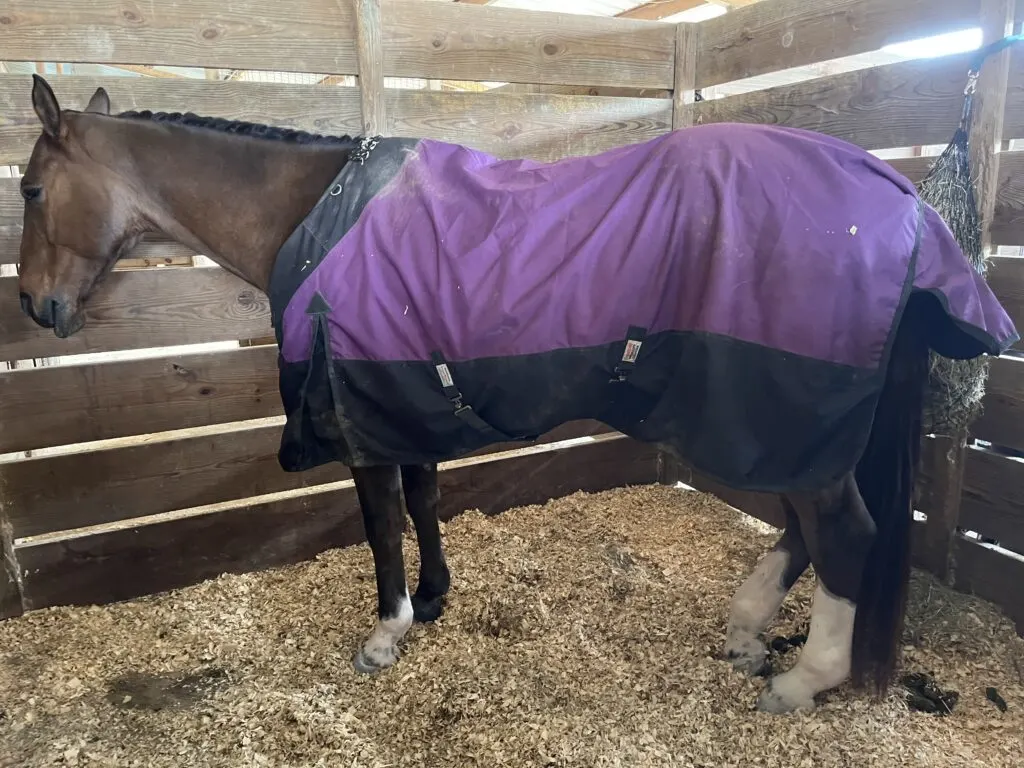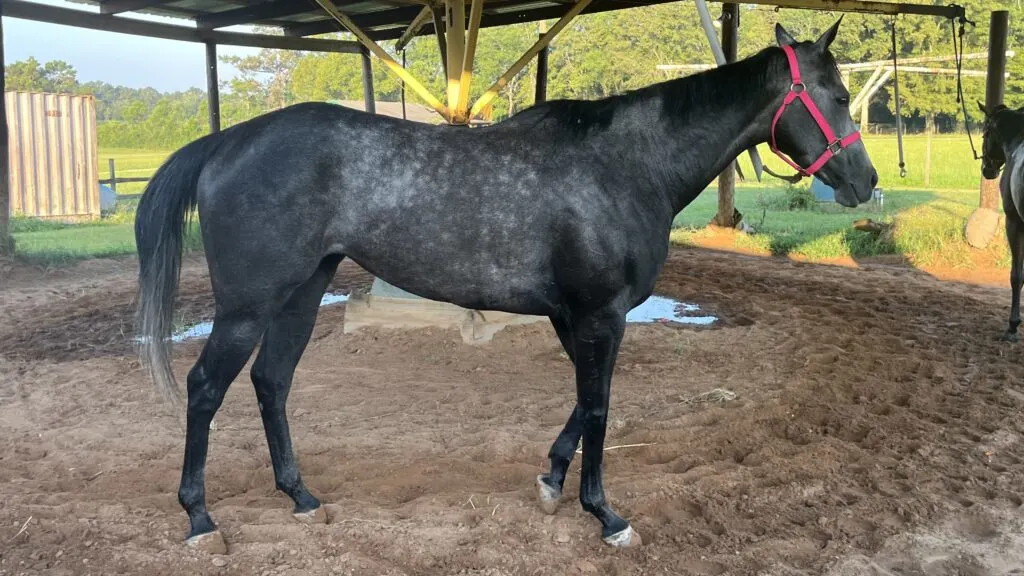Published on: July 21, 2023
When we hear terms like ‘hot-blooded,’ ‘warm-blooded,’ or ‘cold-blooded,’ our minds might go straight to the animal kingdom and their body temperature regulation. But did you know these terms take on a whole new meaning when we’re talking about horses? That’s right; these terms provide insights into a horse’s temperament, breeding, and capabilities.
In horse lingo, ‘hot-blooded’ refers to breeds that are spirited, agile, and speedy, often seen in thoroughbreds and Arabians. ‘Warm-blooded’ horses, on the other hand, are a mix of hot and cold-blooded breeds known for their balance between strength and speed. Lastly, ‘cold-blooded’ horses are typically heavy, calm, and powerful—think the gentle giants of the horse world, like draft breeds.
Knowing these distinctions between hot, warm, and cold-blooded horses isn’t just trivia—it’s key for horse care, selection, and training. This knowledge profoundly impacts how we interact with and understand these majestic animals. So, how do these categories shape a horse’s traits and capabilities? Stay with us to delve deeper into this fascinating aspect of the equestrian world.
What Makes a Horse ‘Hot-Blooded’?
A hot-blooded horse isn’t just a horse with a high temperature! The term refers to horse breeds that have been bred for speed, agility, and spirit. They typically trace their lineage to more temperate climates where horses evolved to be lighter and faster. Thoroughbreds and Arabians are two of the most recognized hot-blooded breeds.

Characteristics of Hot-Blooded Horses
Physically, hot-blooded horses are often more slender and refined in their build, with long legs designed for speed. They possess a high level of endurance, making them excellent competitors in races or other athletic events.
But it’s not just about physical traits—hot-blooded horses also have distinct temperaments. They are typically more sensitive and alert and can be more challenging to handle due to their spirited nature.
Pros and Cons of Hot-Blooded Breeds
Hot-blooded horses are favored for their athleticism and speed, making them a top choice for competitive racing and equestrian sports. Their sensitivity and high energy levels can also lead to a strong bond with their handlers, particularly for experienced horse people who appreciate these traits.
However, these horses can present challenges too. They require experienced handling due to their responsive nature and may not be suitable for beginners. They also tend to require more intensive care and training to keep them physically and mentally stimulated.
Hot-Blooded Breed: The Thoroughbred
Consider the Thoroughbred, one of the most famous hot-blooded breeds. Known for their speed, these horses are a staple in racing. The legendary racehorse Secretariat was a Thoroughbred remembered for winning the Triple Crown in 1973 with record-breaking times that still stand today.
Secretariat’s high spirit, speed, and energy exemplify the hot-blooded horse traits. He required skilled handling and dedicated care, but his achievements speak volumes about the capabilities of hot-blooded horses.
Unraveling the Warm Blooded Horse
If hot-blooded horses are known for their speed and spirit and cold-blooded horses for their strength and calm, where do warm-blooded horses fit in? The term ‘warm-blooded’ describes breeds that fall in the middle of the spectrum.
These horses typically result from crossing hot-blooded breeds for speed and endurance with cold-blooded breeds for strength and stability. The result is a horse that combines the best of both worlds.

Traits of Warm-Blooded Horses
Physically, warm-blooded horses tend to have a balance between the delicate features of hot-blooded breeds and the robustness of cold-blooded ones. They are typically medium-sized, strong yet agile, making them suited to a range of equestrian activities.
Their temperament tends to be balanced as well, offering a blend of the spiritedness of hot-blooded horses and the calm demeanor of cold-blooded breeds. Warm-blooded horses include many of the sport horse breeds, such as Hanoverians and Dutch Warmbloods.
The Double-Edged Sword of Warm-Blooded Breeds
The biggest advantage of warm-blooded horses lies in their versatility. Their balanced physique and temperament make them ideal for many equestrian disciplines, from dressage to eventing. They can form strong bonds with their handlers while also being relatively easy to manage.
On the flip side, their versatile nature can also be a challenge. These horses often need diverse training and exercise routines to satisfy their physical and mental needs. They also may not excel to the same degree in specific areas as their hot or cold-blooded counterparts—lacking the top speed of some hot-blooded horses or the immense strength of some cold-blooded breeds.
Case in Point: The Hanoverian
The Hanoverian breed, a type of warm-blooded horse, showcases the balance these horses offer. Originally from Germany, these horses have been bred to perform in a range of disciplines, including dressage, show jumping, and eventing.
Famous Hanoverians like Salinero, ridden by Anky van Grunsven, have taken home multiple Olympic gold medals in dressage. Salinero’s success demonstrates the versatility, athleticism, and cooperative temperament that make warm-blooded horses such prized partners in the equestrian world.
The Nature of ‘Cold-Blooded’ Horses
When we talk about ‘cold-blooded’ horses, we’re not referring to reptiles or icy body temperatures. Instead, ‘cold-blooded’ is a term used for breeds that are calm, patient, and often of heavier build.
These horses trace their lineage to cooler climates, where breeds developed to be hardy, strong, and reliable. Cold-blooded breeds include the familiar draft horses like Clydesdales and Shires.

Defining Traits of Cold-Blooded Horses
Cold-blooded horses are often physically imposing. They have sturdy bodies and strong muscles and are usually taller and heavier than hot or warm-blooded breeds. Despite their size, they’re known for their calm demeanor, patience, and generally gentle nature. These horses were bred for hard work—pulling, plowing, and carrying heavy loads.
Strengths and Challenges of Cold-Blooded Breeds
The quiet and dependable nature of cold-blooded horses is one of their biggest assets. They’re typically low-maintenance, adaptable, and great for tasks requiring strength and stamina. They can make excellent companions, particularly for less experienced handlers, due to their forgiving and patient nature.
However, their size and strength can also pose challenges. They require larger facilities and more feed, and their powerful build may not suit all equestrian disciplines—especially those requiring speed or high levels of agility.
Spotlight: The Shire Horse
The Shire horse is a prime example of a cold-blooded breed. These gentle giants are one of the tallest horse breeds, and they have a history of performing heavy labor, such as pulling carts and plows. Despite their imposing stature, they’re known for their good nature and patience.
The famous Shire horse, Goliath, held the record for being the tallest horse in the world at over 19 hands high. His size and temperament exemplify the defining characteristics of cold-blooded horses.
Comparison of Hot, Warm, and Cold-Blooded Horses
As we continue our exploration of hot, warm, and cold-blooded horses, it’s time to draw some comparisons. Understanding the distinctions is key, but seeing these types side-by-side really brings the differences—and similarities—to light.
Comparing Hot, Warm, and Cold-Blooded Horses
| Category | Physical Traits | Temperament | Common Breeds |
|---|---|---|---|
| Hot-Blooded | Slender, agile, built for speed | Sensitive, spirited, energetic | Thoroughbreds, Arabians |
| Warm-Blooded | Balanced physique, strong yet agile | Mix of spiritedness and calm | Hanoverians, Dutch Warmbloods |
| Cold-Blooded | Heavy, strong, tall | Calm, patient, gentle | Clydesdales, Shires |

Practical Tips for Handling and Caring for Different Horse Types
As we deepen our understanding of hot, warm, and cold-blooded horses, it’s time to translate this knowledge into practical advice. Whether you’re a prospective horse owner, an equine professional, or a passionate horse lover, knowing how to handle and care for each horse type is crucial.
Hot-Blooded Horses
Hot-blooded horses, with their energetic and sensitive nature, require experienced handling and consistent training. They may not be ideal for novice riders but excel in high-speed sports like racing or endurance events.
- Exercise Regularly: Due to their high energy levels, hot-blooded horses require regular exercise to keep them healthy and content. Without it, they can become restless and challenging to handle.
- Calm and Consistent Handling: These horses tend to be more sensitive and can startle easily. Keeping a calm, steady demeanor will reassure them and promote trust.
- Rich Nutrition: Hot-blooded breeds often require a diet higher in energy to fuel their active nature. Consult with an equine nutritionist to design a suitable meal plan.
My Experience with Hot-Blooded Horses
Owning hot-blooded horses can be as challenging as it is rewarding. As a proud owner of several Thoroughbreds, I’ve seen first-hand just how high-strung and spirited these horses can be. Take my Thoroughbred, Ashton, for instance.
Ashton isn’t mean-spirited, but his playfulness often manifests in jumping and kicking when he’s on a lead rope. To the inexperienced eye, his actions could seem intimidating. But with time, patience, and a deep understanding of his hot-blooded temperament, I’ve learned to interpret and manage his playful actions.
Warm-Blooded Horses
Warm-blooded horses, given their balance of traits, need varied routines to satisfy their physical and mental needs. They’re well-suited for a range of disciplines, including dressage, jumping, and eventing. They can form strong bonds with their handlers and are relatively easy to manage, making them good choices for a variety of horse enthusiasts.
- Varied Routine: Warm-blooded horses enjoy variety in their exercise routine. Mixing different types of work, like dressage, jumping, and hacking, will keep them engaged.
- Balanced Diet: These horses typically need a balanced diet that can support their active lifestyle without overloading them with energy.
- Regular Training: Consistent, regular training is vital to harness their potential and manage their mix of spirited and calm temperament.
Cold-Blooded Horses
Cold-blooded horses, owing to their calm temperament and sturdy build, are excellent workhorses and can be great companions for less experienced handlers. They require more feed and larger facilities due to their size. Their strength and patience make them suited for tasks requiring power, such as carriage pulling or farm work.
- Ample Space: Given their size, cold-blooded horses require larger stalls and pastures. Make sure they have plenty of room to move around comfortably.
- Heavy Feed: These large breeds require a diet that can meet their substantial nutritional needs. They typically need more hay or grass than their smaller counterparts.
- Gentle Training: Cold-blooded horses may not be as quick to learn new things as their hot-blooded counterparts, but their patient and calm nature makes them a joy to train. Gentle, consistent methods work best with these gentle giants.
Remember, each horse is an individual, so these are general guidelines. Always observe your horse’s behavior, consult with professionals, and adjust your care and handling to suit their specific needs.

Tips for Identifying Horse Types
So, now that we’ve dived into the world of hot, warm, and cold-blooded horses, how can you apply this knowledge in real life? In this section, we’ll share some practical tips that can help you identify a horse’s type based on visual cues, behavioral traits, and breed knowledge.
Deciphering Horse Types through Visual Cues
Horses carry their ancestry in their physical appearance, and certain traits can hint at whether a horse is hot, warm, or cold-blooded. Hot-blooded horses often have refined features—a slender body, long legs, and a more delicate head.
Warm-blooded horses are typically of medium size, with a blend of the light build of hot-blooded horses and the sturdiness of cold-blooded breeds. Cold-blooded horses are usually larger and heavier, with strong muscles and larger heads.
Behavioral Clues: The Temperament Tells a Tale
Behavioral traits can also offer clues about a horse’s type. Hot-blooded horses are known for their spirited, sensitive, and energetic behavior. They can be quick to react and may require experienced handling.
Warm-blooded horses usually display a blend of temperaments—generally calmer than hot-blooded horses but more spirited than cold-blooded ones. Cold-blooded horses are typically calm, patient, and gentle, often demonstrating a forgiving nature especially suited to novice handlers.
Breed Knowledge: The Power of Background
Knowing the breed of a horse can often provide a direct line to understanding its categorization. Horse breeds are usually classified as hot, warm, or cold-blooded due to their historical lineage and breeding. For example, if you know a horse is a Thoroughbred, you can confidently categorize it as a hot-blooded horse.

Wrapping It Up
We’ve embarked on a fascinating journey to understand the differences between hot, warm, and cold-blooded horses. From the spirited and speedy hot-blooded breeds to the balanced and versatile warm-blooded ones, and the gentle, powerful cold-blooded giants, we’ve seen how each type comes with its own unique traits, benefits, and challenges.
Recognizing these differences isn’t just an exercise in equine trivia—it’s an essential tool for anyone involved with horses. It can guide you in providing the right care, devising suitable training plans, and even determining the best horse for specific tasks or disciplines.
It allows you to better appreciate and accommodate the needs and abilities of these majestic creatures. So, the next time you’re at a stable, farm, or equestrian event, take a moment to observe the horses around you. Try to identify their type based on their physical traits, behavior, or breed.
You might be surprised at how this newfound knowledge can enhance your understanding and interaction with these amazing animals. And remember, whether hot, warm, or cold-blooded, every horse has its unique charm and potential waiting to be appreciated and harnessed.
